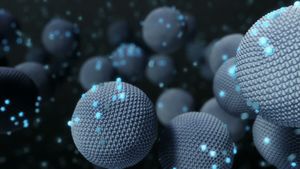
Nanomaterials are nanoscopic materials which have unique shape shifting properties. The nanomaterials are made up of a complex combination of quantum particles creating a kind of quantum-alloy which shares properties along the spectrum between matter and energy. Due to their unique properties the nanomaterials cannot be replicated.
Composition
A single quantum of material is a spherical construction of quantum-alloys. The natural state of a the single sphere of quantum-alloys is roughly similar to mercury in consistency, though slightly larger in size to a mercury atom atom and considerably denser. The individual spheres are then arranged to various structures and can be manipulated to generate a wide range of desired properties. Nanomaterial is made up of trillions of these singular quantum alloy spheres which combine in a way similar to that of molecules and can rearrange and construct themselves according to the patterns given to them.
Given the inert state of nanomaterials they naturally take on the form of a very dense and thick liquid metal substance.
Control
The compositional properties of nanomaterial is controlled via patterned energy fields implanted upon the structure by a controlling computer. The materials are capable of changing themselves in real time to the pattern of the computer and can even alter themselves in such a way to transmit this pattern throughout even vast structures. Most patterns can be made stable through manipulation of the materials so that when a controlling field is not present, the construct retains the properties it was given when a pattern was last applied -- that is they will retain the last pattern received. This is not always the case, some exotic patterns of mattern require constant control due to the pattern itself becoming unstable and requiring constant adjustments at the control of a computer to keep the construct stable.
Unstable constructs will revert to their natural state if the pattern fails to maintain integrity.
At this time the Encapsulated Computer Core can be combined with a Spacial Variance Reactor as a reliable power source and control system for a nanomaterial construct.
Stability
The laws of thermodynamics still apply, while the material itself can blur the lines between matter and energy a pattern will become unstable very quickly if it begins to violate the laws of thermodynamics. Particularly with the laws of the conservation of matter and energy; it is possible for the materials to be used to generate more materials if given enough energy or to be deconstructed and generate energy from their mass. However, this follows the relativistic conversion for energy into matter and quickly becomes unstable in either direction. A controlling computer could be capable of maintaining a field pattern but experimental analysis shows that the computing power required grows exponentially as the pattern is forced to become more and more complex and to change at a faster and faster rate in order to keep up with the conversion.
Stability of a structure can be maintained by keeping the energy generated from the system largely within the system itself. This system of material can be structured then to retain energy fed into it and thus use that energy to power constructed elements within the existing nanomaterial structure. This should not be confused with generating new matter from energy fed into the system, the materials can hold energy and use that energy for various processes but that energy is not then converted into nanomaterials itself. Similar with matter, normal matter can be contained within the materials and used for various purposes but does not itself become more nanomaterials.
Source
The source of nanomaterials is in the quantum-alloys which are actually generated by nanites within an exotic field environment. The nanites are specially constructed in order to a generalized exotic mix of subspace, temporal, and gravitational field manipulations in order to generate an environment where the nanites are able to reorganize the quantum particles into these unique structures. The process is relatively slow but the area of the exotic field environment is exponentially proportional to the amount of material that can be produced at one time.
Using in Construction
When using nanomaterials to construct an object, the actual object's base design should be constructed and fully usable as an actually constructed item. While it is possible to program a system to use different patterns that have not been physically constructed, it is unwise. For best practices an object should be constructed using conventional materials to perform the same functions and have the same capabilities as the object being patterned. This ensures that an object's pattern is stable as it has been confirmed to exist out of actual materials.
Once constructed it can be patterned by the computer down to the molecular or quantum levels similar to how a transporter operates and then that pattern can be used to control the nanomaterials. Shapeshifting a nanomaterial construct also should be done by adding patterns from actual constructed devices to the original, this again confirms that the end result pattern is stable and works. The computer can then generate a way to move a construct from one pattern to the next and maintain the stability of the construct as a whole.